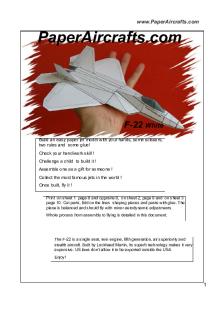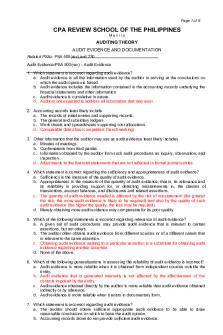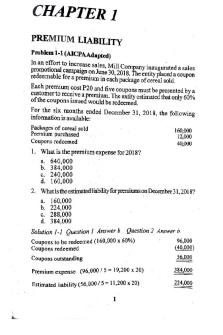F-22 Raptor paperaircrafts pdf free PDF

| Title | F-22 Raptor paperaircrafts pdf free |
|---|---|
| Course | Management |
| Institution | Universitatea Ovidius Constanta |
| Pages | 36 |
| File Size | 31.5 MB |
| File Type | |
| Total Downloads | 21 |
| Total Views | 126 |
Summary
F-22 Raptor paperaircrafts pdf free F-22 Raptor paperaircrafts pdf free F-22 Raptor paperaircrafts pdf free F-22 Raptor paperaircrafts pdf free F-22 Raptor paperaircrafts pdf free F-22 Raptor paperaircrafts pdf free...
Description
www.PaperAircrafts.com
PaperAircrafts.com
F-22 White Build an easy paper jet model with your hands, some scissors, two rules and some glue! Check your handiwork skill ! Challenge a child to build it ! Assemble one as a gift for someone ! Collect the most famous jets in the world ! Once built, fly it ! Print on sheet 1 page 8 and opposite 8, on sheet 2, page 9 and on sheet 3 page 10. Cut parts, fold on the lines shaping pieces and paste with glue. The plane is balanced and should fly with minor aerodynamic adjustments. Whole process from assembly to flying is detailed in this document.
The F-22 is a single seat, twin engine, fifth generation, air superiority and stealth aircraft. Built by Lockheed Martin, its superb technology makes it very expensive. US laws don’t allow it to be exported outside the USA Enjoy!
1
www.PaperAircrafts.com
Index How to build it………………...3 Note about printing Parts ….7 Airplane Parts……………......8 Airplane Stand …………..….11 Assembling…………………..12 How to fly it…………..……....28
Copyright Notice All rights reserved. No part of this document may be reproduced or transmitted in any form or by any means, electronic or mechanical. Any unauthorized use, sharing, reproduction, or distribution of parts herein is strictly prohibited. The buyer of this ebook may print as many copies as he want for his personal use. Legal Notice While attempts have been made to verify the correctness and reliability of the information provided in this document, the author do not assume any responsibilities for errors, omissions, or contradictory information contained in this publication. The reader of this book assumes all responsibility and liability for the use of the information and materials described in it, (like glue or scissors).
2
www.PaperAircrafts.com
How to build it Tools: Two rules to fold paper accurately
Transparent liquid contact glue
Sccissors
Thin stick
3
www.PaperAircrafts.com
!
Note about Glue
A suitable glue should have these features: -Accurate application. So that you can easily put a string of glue over a narrow paper tab. -Transparent. The airplane will look better if too much glue is applied and it overflows tabs' boundaries. -It should dry fast enough. Two minutes keeping a part in place should give the glue enough strenght to release the part and go for the next. -It should dry slow enough. The glue must allow during a time to shift a part to its correct position before it gets hardened. -And most important: The glue must not bend or wrinkle the paper. Before start assembling the airplane, check your glue: Spread some glue in a sheet of paper and wait some minutes. If the paper gets wrinkled or wavy, then, that glue is not valid for paper; the aircraft would be deformed and look ugly.
√
X
Suitable glues could be “transparent liquid contact glue” usually for repairing shoes. They can be found at “Glues” section in big shopping centres or hardware stores. 4
www.PaperAircrafts.com Print pages 8, 9 and 10 in common paper A4 or Regular Letter. Using a paper with basis weight 20lb // 80gr/m2 would simplify the balancing process. Print at scale 100% to avoid parts distortion and using option ”Autorotate and center pages”. Do not “fit to page” or “shrink to page”. Cut parts over the external lines. Fold over the lines with the help of the rules to obtain the shape of each part.
Note that you can fold the paper on the lines with the help of the rules, (to the opposite side) and after it, with your fingers, on the same line, to the correct side to obtain the final piece shape.
5
www.PaperAircrafts.com Paste parts puting glue on the overlaping surfaces.
Put little amount of glue. Otherwise, the airplane would look ugly and it would weight too much.
√ X
6
www.PaperAircrafts.com
Note about printing Parts Use either letter or DIN A4 formats, preferably with basis weight 20lb // 80gr/m2 . There are four pages with parts to be printed on three sheets of paper. Page opposite 8 must be printed behind page 8, in order to the plane was correctly decorated. Check option “Auto-rotate and center pages” but do not “fit to page” or “shrink to page”. Print at 100% scale. You needn’t to print the rest of the document. View it on the screen and zoom in when needed.
Page 8
Page 9
Sheet 2
Sheet 1
Page opposite 8
Page 10
Sheet 3
If you want to build a static model (not to fly) you could print on a high quality paper in high resolution. But if you want a flying model it is better to use normal paper. A basis weight 20lb//80gr paper is perfect to fold and fly. As thicker is the paper as more difficult to fold and heavier the plane to fly. 7
www.PaperAircrafts.com F-22 Stand 2
1
2
1
3↑
F-22 3
1↓ 3
11
2↓
www.PaperAircrafts.com 11
29 22
18 21 UJ2
UJ3
2
UJ1
6 10 19 7 14
12 9
16
8 9 15 13 1 28 28
23 20
25 27 4 3 LJ2
26
24 LJ1
17
5 12
www.PaperAircrafts.com
13
www.PaperAircrafts.com About assembling It means: part number 1 It means: part 7 pasted here (this side) It means: part 24 pasted here (opposite side) It means: line of glue
1
1.1
2.1 19
Opposite sides
Front sides 2.2
2.3
2.4
2.5
3.1
3.2
1
3.3
3.4
4.1
14
www.PaperAircrafts.com 4.2
5.1
5.2
5.3
6.1
6.2 23
6.3
7.1
7.2 14
13
7.3
7.4
7.5
14
13
8.1
20
8.2
8.3
15
www.PaperAircrafts.com 8.4
20
8.5
9.1
27
9.2
9.3
9.4 27
9.5
9.6
10.1
2
3
10.2
10.3
10.4
10.5
10.6
10.7
3
16
www.PaperAircrafts.com 10.8
10.9
11.1
26
11.2
11.3
11.4
UJ1 LJ1
11.5
LJ1
11.6
UJ2
UJ3
LJ2
11.7
LJ2
11.8
11.9
11.11
11.12
26
11.10
11.13
17
www.PaperAircrafts.com 12.1
12.2
12.3
12.5
13.1
17
12.4
17
25
13.2
13.3
13.4 24
13.5
13.6
13.7
25 24
13.8
13.9
14.1
18
www.PaperAircrafts.com 14.2
1
14.3
14.4
2
Do not apply glue now 14.5
15.1
15.3
16.1
15.2
19
16.2
12
16.3
16.4
16.5
9 9
16.6
16.7
9
9
8
12
16.8
8
19
www.PaperAircrafts.com 16.9
17.1
16.10
16.11
17.2
17.3
18.1
18.2
2
17.4
10
18.3
18.4
19.1
19.2
10
18.5
19.3
7
20
www.PaperAircrafts.com 19.4
19.5
20.1
20.2
20.3
20.4
6
UJ1 UJ2 UJ3
20.5
20.6
20.7
20.8
20.9
20.10
6
20.11
21.1
21.2
29
29
21
www.PaperAircrafts.com 21.3
22.1
22.2
18
22.3
22.4
22.5
18
23.1
23.2
24.1
15
24.2
24.3
24.4 15
24.5
25.1
25.2
28
28
22
www.PaperAircrafts.com 25.3
25.4
25.5 28
25.6
26.1
26.3
26.4
28
28
16
26.2
26.5
16
26.6
27.1
27.2
4
5
27.3
27.4
27.5
5
23
www.PaperAircrafts.com 27.6
27.7
28.1
4
27.8
28.2
28.3
28.5
28.6
21
22
28.4
29.1
22
21
29.2
29.3
29.5
29.6
11
29.4
11
24
www.PaperAircrafts.com
25
www.PaperAircrafts.com 1
F-22 Stand
2.1
2.2
2.3
2.4
2.5
2.6
2.7
2.8
2.9
2.10
2.11
2.12
26
www.PaperAircrafts.com 2.13
2.14
2.15
2.16
2.17
2.18
2.19
2.20
2.21
27
www.PaperAircrafts.com Elevator
How to fly it
Aileron
Rudder
Flap
Leading Edge Flap
1
Aerodynamic cleanness
√
X
If surfaces are bent, force the paper with your fingers trying to straighten them. The airplane may have defects, but they must be symmetrical. 28
www.PaperAircrafts.com
2
Aircraft balanced
Rest the airplane on two fingers so that the lower wing circles get positioned just over them. If it keeps levelled and does not fall…it is balanced.
√
Ready to fly
If it falls forward, the nose is too heavy. Put a load in the tail.
If it falls backward, it needs more weight in the nose. Did you paste parts 17,18,15 and 28? Add some pieces of paper if needed.
29
www.PaperAircrafts.com
3 Throwing
It is easier to throw the airplane keeping it on the sight line and impelling it on its longitudinal axis. 2.
1.
Previously to the first flight, deflect elevator upward gently.
√ X 1.
2.
2.
1.
Once the easy throwing is well trained, try to launch over head for a longer flight
X 3.
3.
√ 30
www.PaperAircrafts.com
4
Correcting the flight path: Pitch
If the aircraft pitchs down going to the ground, deflect the elevator upward gently. Repeat the flight. If it keeps going down, deflect the elevator upward a little more until the aircraft went straight gliding.
If the gliding path osciles like above… the elevator may be too much deflected upward. Reduce the elevator upward deflection.
In this case the nose still needs a little more weight. Add some pieces of paper in the nose. 31
www.PaperAircrafts.com If you achieve to stabilize the glide path but it is too inclined downward… the nose may be too heavy. Try to remove part of piece 28 or put weight on the tail and reduce the elevator upward deflection.
+ 5 Correcting the flight path: direction
√
In order to correct the turn, deflect ailerons asymmetricaly like each picture shows but very gently. Deflections in the pictures are exaggerated; you would obtain the opposite effect. 32
www.PaperAircrafts.com
In case of little corrections in direction, you can use the rudders. Deflect them very gently.
Correct left turns deflecting rudders right
Correct right turns deflecting rudders left.
Slipped flight has poor glide ratio. The airplane somehow flights sideways and a little banked. Tails and wings may not be fine.
Flight path
Flight path
Left slip: tails driving right, wings driving left
Right slip: Tails driving left, wings driving right
Correct left slip deflecting rudders left and ailerons driving right
Correct right slip deflecting rudders right and ailerons driving left 33
www.PaperAircrafts.com
6 Adding lateral stability If the airplane flights suddenly banking to both sides, even until staying upside down, (mostly on gusty wind); adding dihedral angle, (folding wings upward a little), may improve the flight.
34
www.PaperAircrafts.com
7 Advanced Flight Once you have calibrated the glide path in pitch and direction, you can try different airplane performances.
“Cruise”:
Deflect down the leading edge flaps a little.
The airplane will pitch down, oppose it, rising the elevators a little.
The airplane will fly more smoothly
“Approach”: Deflect down the flaps and the LE flaps a little more. Compensate the pitch down, rising the elevators if needed.
The airplane will fly slower.
“Landing”:
Deflect down the flaps significantly.
Compensate the pitch down, rising the elevators.
The airplane will fly more slowly with a shorter glide path. 35...
Similar Free PDFs

F-22 Raptor paperaircrafts pdf free
- 36 Pages

CPAR Reviewer PDF free
- 6 Pages

Guía rápida para usar raptor
- 3 Pages

Free Movement of Workers pdf
- 1 Pages

Reviewer 47 pdf free - helpful
- 152 Pages

Pdfcoffee.com 1-liabpdf-pdf-free
- 25 Pages

Bollinger Bands Explained Free PDF
- 12 Pages

Free Movement of Goods pdf
- 1 Pages

Diagrama de flujo en raptor
- 1 Pages

F-35 - f35 f16 f22
- 32 Pages

G.R No-109248 Summary-pdf-free
- 2 Pages
Popular Institutions
- Tinajero National High School - Annex
- Politeknik Caltex Riau
- Yokohama City University
- SGT University
- University of Al-Qadisiyah
- Divine Word College of Vigan
- Techniek College Rotterdam
- Universidade de Santiago
- Universiti Teknologi MARA Cawangan Johor Kampus Pasir Gudang
- Poltekkes Kemenkes Yogyakarta
- Baguio City National High School
- Colegio san marcos
- preparatoria uno
- Centro de Bachillerato Tecnológico Industrial y de Servicios No. 107
- Dalian Maritime University
- Quang Trung Secondary School
- Colegio Tecnológico en Informática
- Corporación Regional de Educación Superior
- Grupo CEDVA
- Dar Al Uloom University
- Centro de Estudios Preuniversitarios de la Universidad Nacional de Ingeniería
- 上智大学
- Aakash International School, Nuna Majara
- San Felipe Neri Catholic School
- Kang Chiao International School - New Taipei City
- Misamis Occidental National High School
- Institución Educativa Escuela Normal Juan Ladrilleros
- Kolehiyo ng Pantukan
- Batanes State College
- Instituto Continental
- Sekolah Menengah Kejuruan Kesehatan Kaltara (Tarakan)
- Colegio de La Inmaculada Concepcion - Cebu




